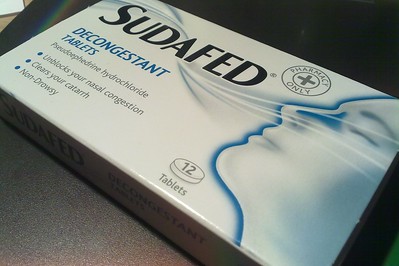Decongestants
Decongestant medications have been available over the counter (drugs that you can buy at a pharmacy without a prescription) for years. Although they are readily available, considerations are necessary when taking any drug. In this chapter we will explore these drugs further.

Pseudoephedrine
Pseudoephedrine is an over-the-counter (OTC) decongestant (see Figure 5.7[1]). More details regarding pseudoephedrine are described in the “Autonomic Nervous System” chapter.
Mechanism of Action
Pseudoephedrine acts directly on the adrenergic receptors and acts indirectly by releasing norepinephrine from its storage sites. The drug produces vasoconstriction, which shrinks nasal mucosa membranes.
Indications for Use
Decongestants relieve nasal obstruction due to inflammation.
Nursing Considerations Across the Lifespan
This medication is not safe for children under the age of 4 years.
Adverse/Side Effects
Common adverse/side effects include hypertension, dysrhythmia, dizziness, headache, insomnia, and restlessness. Some clients may experience blurred vision, tinnitus, chest tightness, dry nose, and nasal congestion.
Decongestants are contraindicated in clients with severe hypertension, coronary artery disease (CAD), narrow-angle glaucoma, and some antidepressant use. Also, clients who have cardiac dysrhythmias, hyperthyroidism, DM (diabetes mellitus), prostatic hypertrophy, and glaucoma should use with caution.[2]
Client Teaching & Education
Client must take care to follow dosing recommendations. If dosing standards are surpassed, some clients may experience side effects such as increased nervousness, breathing difficulties, heart rate changes, and hallucinations.[3]
Pseudoephedrine Medication Card
Now let’s take a closer look at the medication drug card on Pseudoephedrine. Medication cards are intended to assist students to learn key points about each medication class. Basic information related to a common generic medication in this class is outlined, including administration considerations, therapeutic effects, and side effects/adverse effects. Prototype/generic medication listed in the medication card is also hyperlinked to a free resource from Daily Med. Because information about medication is constantly changing, nurses should always consult evidence-based resources to review current recommendations before administering specific medication.in Table 5.7.[4], [5], [6].
Medication Card 5.7.1: Pseudoephedrine
Class: Decongestants
Prototypes: Pseudoephedrine (Sudafed)
Mechanism: Sudafed is an over the counter decongestant. It acts on the adrenergic receptors by releasing norepinephrine from its storage sites. This causes vasoconstriction-shrinking nasal mucosa membranes.
Therapeutic Effects
- Relieves nasal congestion
- Relieves sinus congestion
- Decreases sinus pressure and decrease pain
Administration
- Do not crush, chew, or break an extended release tablet
- Oral suspension is available, ensure proper measuring and dose
- Adult Doses: Immediate release: 30 to 60 mg orally every 4 to 6 hours as needed.
Sustained release: 120 mg orally every 12 hours as needed.
Sustained release suspension: 45 to 100 mg orally every 12 hours as needed.
Maximum daily dose is 240 mg/day.
Indications
- Use of nasal congestion due to common cold and hay fever
- Upper respiratory allergies
- Temporarily relieves sinus congestions and pressure
Contraindications
- Avoid using prolonged- greater than 7 days
- Only use this medication if advised by prescribing practitioner or pharmacist if the person has heart disease since is acts as a sympathomimetic
- This drug is banned for professional sports by the World Anti-Doping Agency as it is a stimulant and is claimed to enhance performance
- DO not use in children under 4 years of age
- DO not take if taking MAO inhibitors within 14 days, this leads to serious side effects.
- DO not take if taking caffeine pills, diet pills or other stimulants such as ADHA medications
Side Effects
- Rebound congestion with nasal route
- Cardiovascular stimulation-fast heartbeat or pounding heart beat sensation
- Dizziness or anxiety
- Dangerously high blood pressure
- Loss of appetite
- Fever, headache, cough, or skin rash-contact doctor
SAFETY: Cautious when administering to cardiac patients due to the stimulation it can cause
- Death can occur in misuse of cough and cold drugs in very young children
- Many over the counter drugs have combination of cough and cold drugs mixed together read the label to ensure you are not taking more drugs than indicated
- Can cross into breast milk and could harm a nursing baby
Nursing Considerations
- Drink at least 2-3 litres of water per day
- Ensure prescribing doctor thinks its ok to take this medication if the person has heart disease, diabetes or a thyroid disorder
- "Project 366 #165: 130612 Helping Hand?" by Pete is licensed under public domain ↵
- Frandsen, G. & Pennington, S. (2018). Abrams’ clinical drug: Rationales for nursing practice (11th ed.). Wolters Kluwer. ↵
- uCentral from Unbound Medicine. https://www.unboundmedicine.com/ucentral ↵
- This work is a derivative of Pharmacology Notes: Nursing Implications for Clinical Practice by Gloria Velarde is licensed under CC BY-NC-SA 4.0. ↵
- Frandsen, G. & Pennington, S. (2018). Abrams’ clinical drug: Rationales for nursing practice (11th ed.). Wolters Kluwer. ↵
- This work is a derivative of Daily Med by U.S. National Library of Medicine in the public domain. ↵

